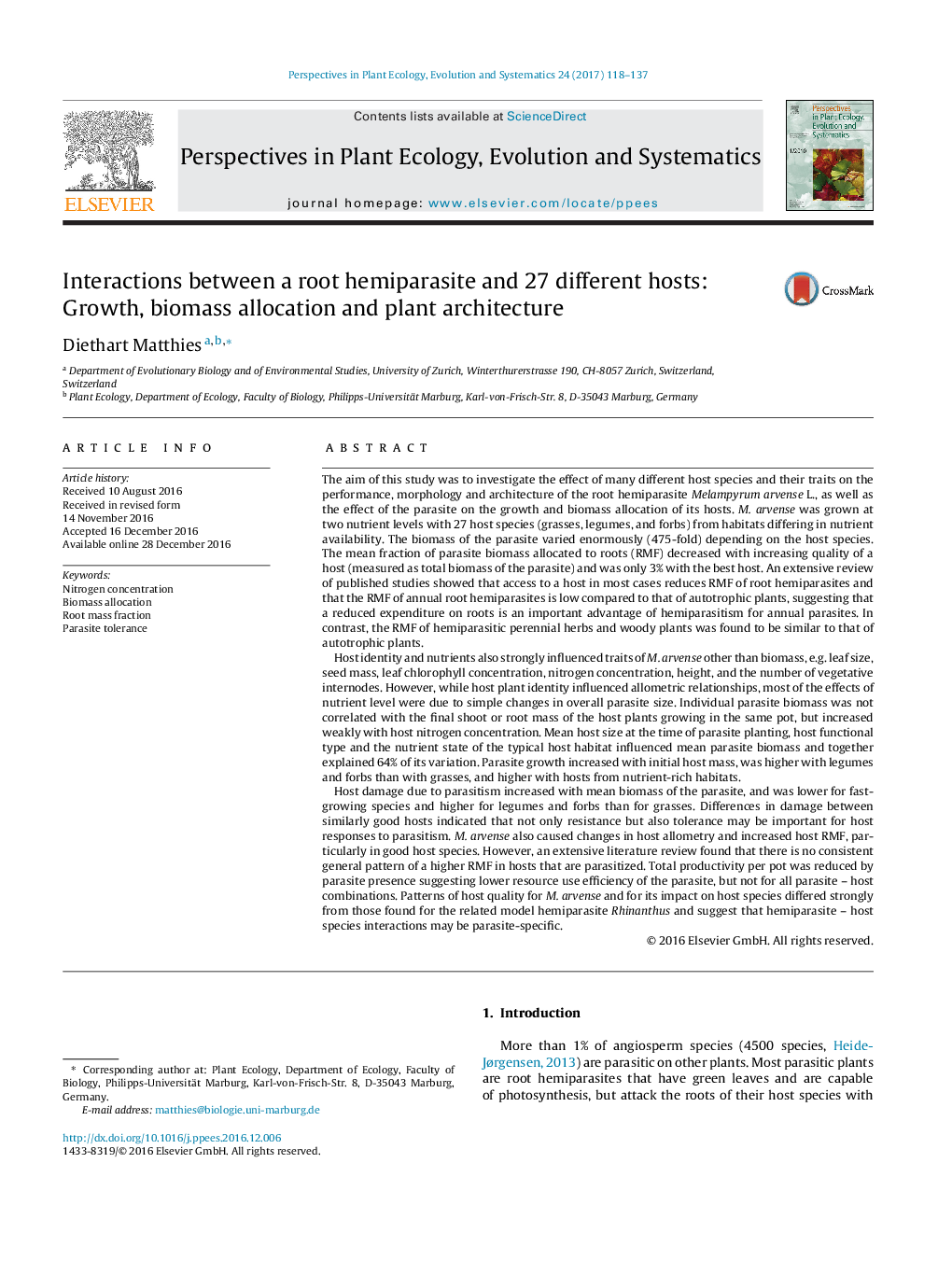| Article ID | Journal | Published Year | Pages | File Type |
|---|---|---|---|---|
| 5744986 | Perspectives in Plant Ecology, Evolution and Systematics | 2017 | 20 Pages |
â¢Host quality for the hemiparasite varied enormously (475-fold) among species and varied within functional groups.â¢Host species identity influenced hemiparasite architecture and morphology.â¢Resistence, but also tolerance of hosts to parasitism varied.â¢Good hosts suffered more from parasitism than poor hosts.â¢Parasitism increased host RMF, particularly in good host species.
The aim of this study was to investigate the effect of many different host species and their traits on the performance, morphology and architecture of the root hemiparasite Melampyrum arvense L., as well as the effect of the parasite on the growth and biomass allocation of its hosts. M. arvense was grown at two nutrient levels with 27 host species (grasses, legumes, and forbs) from habitats differing in nutrient availability. The biomass of the parasite varied enormously (475-fold) depending on the host species. The mean fraction of parasite biomass allocated to roots (RMF) decreased with increasing quality of a host (measured as total biomass of the parasite) and was only 3% with the best host. An extensive review of published studies showed that access to a host in most cases reduces RMF of root hemiparasites and that the RMF of annual root hemiparasites is low compared to that of autotrophic plants, suggesting that a reduced expenditure on roots is an important advantage of hemiparasitism for annual parasites. In contrast, the RMF of hemiparasitic perennial herbs and woody plants was found to be similar to that of autotrophic plants.Host identity and nutrients also strongly influenced traits of M. arvense other than biomass, e.g. leaf size, seed mass, leaf chlorophyll concentration, nitrogen concentration, height, and the number of vegetative internodes. However, while host plant identity influenced allometric relationships, most of the effects of nutrient level were due to simple changes in overall parasite size. Individual parasite biomass was not correlated with the final shoot or root mass of the host plants growing in the same pot, but increased weakly with host nitrogen concentration. Mean host size at the time of parasite planting, host functional type and the nutrient state of the typical host habitat influenced mean parasite biomass and together explained 64% of its variation. Parasite growth increased with initial host mass, was higher with legumes and forbs than with grasses, and higher with hosts from nutrient-rich habitats.Host damage due to parasitism increased with mean biomass of the parasite, and was lower for fast-growing species and higher for legumes and forbs than for grasses. Differences in damage between similarly good hosts indicated that not only resistance but also tolerance may be important for host responses to parasitism. M. arvense also caused changes in host allometry and increased host RMF, particularly in good host species. However, an extensive literature review found that there is no consistent general pattern of a higher RMF in hosts that are parasitized. Total productivity per pot was reduced by parasite presence suggesting lower resource use efficiency of the parasite, but not for all parasite - host combinations. Patterns of host quality for M. arvense and for its impact on host species differed strongly from those found for the related model hemiparasite Rhinanthus and suggest that hemiparasite - host species interactions may be parasite-specific.
